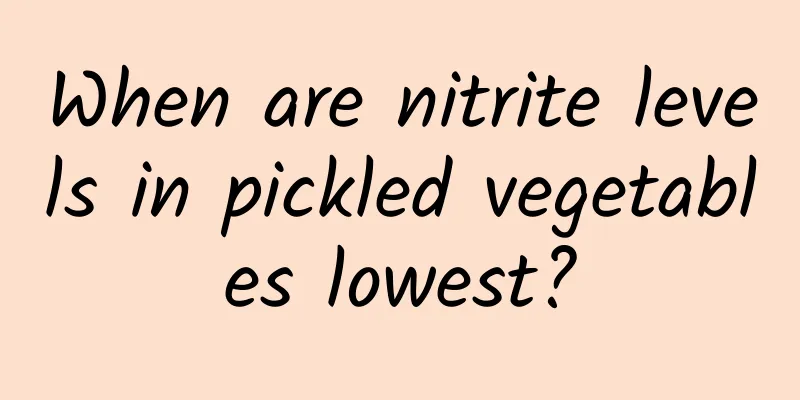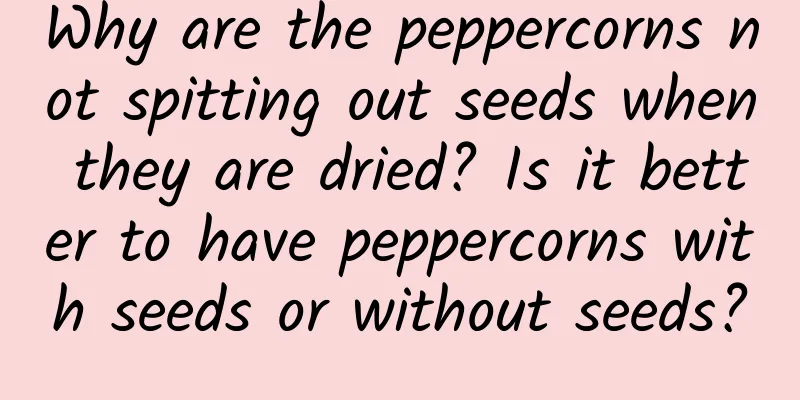When are nitrite levels in pickled vegetables lowest?

|
After the Waking of Insects, everything comes back to life. It is time to cultivate the land. I believe that a large number of fresh vegetables will be ripe soon. So let's eat more fresh vegetables and less pickled vegetables! Why? Then read on: Recently, a 5-year-old girl in Zhuji, Zhejiang Province, showed symptoms of poisoning after eating homemade pickled vegetables. She was diagnosed with nitrite poisoning. When she was sent to the hospital, her lips were purple and she had obvious symptoms of hypoxia. Fortunately, she was out of danger after treatment. Let’s talk about the “nutritional secrets” of pickled vegetables today. Nitrite can cause hypoxia The toxicity of nitrite lies mainly in its ability to oxidize hemoglobin into methemoglobin, which causes hypoxia and leads to cyanosis. It is generally believed that adults may experience poisoning reactions if they ingest more than 200 mg of nitrite at one time. However, infants and children are at greater risk because their digestive systems and methemoglobin reductase systems are not yet fully developed, making them more susceptible to nitrite-induced methemoglobinemia, commonly known as blue baby syndrome, a rare condition in which hemoglobin fails to carry oxygen to various body tissues, causing the skin and lips to turn blue. Why is there nitrite in pickled vegetables? Vegetables themselves contain a lot of nitrates, which will be converted into nitrites by bacteria during the pickling process. Vegetables absorb nitrogen from nitrogen fertilizer or soil during their growth process, and the nitrogen is converted into nitrates in the body. Then, during the pickling process, the nitrates are converted into toxic nitrites by some bacteria. The nitrite content in pickled vegetables has a process of first increasing and then decreasing. For ordinary pickled vegetables, the nitrite content will continue to rise when pickling begins. This is because the nitrate contained in the vegetables is converted into nitrite by the nitrate reductase in the bacteria. At the peak of nitrite, the content can reach more than 100 mg/kg or even higher. Therefore, the nitrite content of pickled vegetables at the peak period will be very high, and may reach a nitrite level that can cause disease. Do not eat them, let alone give them to children. In addition, the amount of nitrite produced by kimchi is also closely related to the fermentation bacteria. Studies have found that if pure acetic acid bacteria or pure lactic acid bacteria are used during fermentation, it will not lead to the production of a lot of nitrite, because these bacteria almost do not produce nitrite. However, when many people make their own kimchi, they do not have the conditions for pure bacterial fermentation, which inevitably contaminates miscellaneous bacteria and is more likely to produce nitrite. Here we also remind everyone to try not to pickle kimchi yourself. The nitrite content in pickled vegetables has a peak value However, this does not mean that all pickled vegetables cannot be eaten. In fact, the nitrite content in pickled vegetables does not necessarily exceed the standard. In fact, during the pickling process, the nitrate in the pickled vegetables will also disappear on its own. After the peak period, the nitrite in the pickled vegetables will slowly decrease. During the peak period, the pickled vegetables have a high nitrite content and are not suitable for consumption. But after the peak period, when the nitrite content decreases, you can eat it. The peak period lasts for different durations for different vegetables. Generally speaking, the highest level of nitrite in pickled vegetables occurs between two or three days and ten days after the start of pickling. Moreover, this time is also affected by fermentation temperature, salt content, etc. Generally speaking, when the temperature is high and the salt concentration is low, the peak of nitrite appears earlier; conversely, when the temperature is low and the salt content is high, it appears later. But from the current point of view, after 20 days, the pickled vegetables will reach a safe level, and it is safer to eat them at this time. Therefore, for the sake of caution, it is recommended that you pickle for at least 20 days before eating. Pickled vegetables that have been pickled for more than a month can be eaten with more ease. Can children eat kimchi? As a pickled food, kimchi is not a healthy choice. First, kimchi is pickled, which means it contains a lot of salt and is a high-salt food. Although kimchi today uses added sugar and preservatives to help preserve it in order to cater to consumer demand, the salt content is much less, but it is still not low and is not good for health to eat. Second, the nutritional value of kimchi is much lower than that of fresh vegetables. For example, it contains almost no vitamin C. Some studies have also found that eating pickled vegetables frequently may increase the risk of cancer. According to the food and health data compiled by the Chinese Nutrition Society, based on current scientific research, eating too much pickled food increases the risk of esophageal cancer, gastric cancer and high blood pressure, as well as the risk of breast cancer in women, possibly because kimchi contains a lot of sodium. So, kimchi is something that you should just eat occasionally. How should kimchi be eaten? Kimchi tastes sour and refreshing, and can stimulate appetite, so many people still want to eat some. So, how can we eat kimchi more healthily? First, don’t eat kimchi that is not fully pickled, and try not to eat homemade kimchi. Pickles that are only pickled for two or three days to more than ten days are not pickled thoroughly and have the highest nitrite content, so they should not be eaten. It is best to eat them after they have been pickled for 20 days. Homemade pickles are easily contaminated by miscellaneous bacteria and may contain more nitrite, so try not to eat them. Second, don’t eat too much. The biggest problem with kimchi is its high salt content, so eat it in moderation and only occasionally. Third, use it instead of salt in cooking. Although the vitamin C content is very low, pickled vegetables are rich in potassium and dietary fiber. Salt is needed when cooking anyway, so it is better to use pickled vegetables instead of salt. As long as the saltiness is controlled, it can also add some minerals and dietary fiber compared to adding salt directly. Pickles can also make dishes more fragrant and delicious. By Ruan Guangfeng (Director of the Science and Technology Department of the Food and Nutrition Information Exchange Center) |
>>: What is the nutritional value of black beans? How to quickly cook black beans
Recommend
What is breast hyperplasia
Nowadays, due to the active publicity of breast d...
What to do if your breasts sag and expand after childbirth
The problem of sagging and outward expansion of b...
How to make menstruation stop faster
What annoys some girls the most are the days when...
Why do hardworking employees leave first? What kind of employees work hard but don't stay long?
Why do some people who work hard sometimes resign...
What are the dangers of getting angry during pregnancy?
When a woman is pregnant, her mood may sometimes ...
Can you apply ice or toothpaste after a burn? Remember these five words for correct first aid →
rId5...
What diseases can Ba Duan Jin cure? How long does it take to see results from practicing Ba Duan Jin?
Ba Duan Jin is an independent and complete set of...
Which exercise is the best for breast enhancement?
Breast development is the second sign of female p...
Unhealthy lifestyle shortens women's life
The quality of a person's lifestyle largely d...
Phage therapy: new hope in the fight against antibiotic resistance
Author: Duan Yuechu and Huang Yanhong In the vast...
How long does it take to give birth?
Pregnancy and childbirth are both time-controlled...
Can female stigma be cured?
In the early stages, genital warts appear milky w...
How long does a positive ovulation test usually last?
Nowadays, many female friends generally use ovula...
What are the side effects of breast enhancement milk?
Everyone pays special attention to breast enhance...
How should ectopic pregnancy be treated?
Many women find that they still have vaginal blee...









